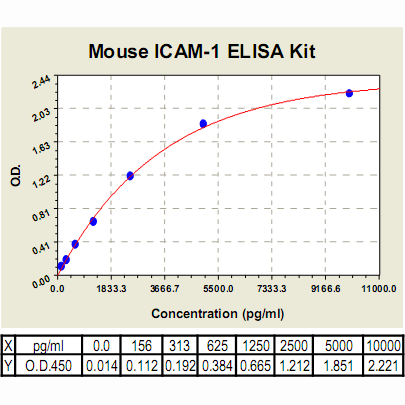Product Sheet CL0371
Description
BACKGROUND ICAM-1(intercellular adhesion molecule-1) is a transmembrane glycoprotein of 532 amino acids, which has a molecular mass ranging from 90 to 110 kDa. ICAM-1 is a member of the immunoglobulin supergenge family, and contains five extracellular immunoglobulin-like domains. It is expressed on various cells of both hematopoietic and non-hematopoietic cells, including endothelial cells, leukocytes other than basophilic granulocytes, T cells, B cells, fibroblasts, and cancer cells. As a member of adhesion molecules, ICAM-1 binds to two integrins belonging to the beta2 subfamily CD11a/CD18 (LFA-1) and CD11b/CD18 (Mac-1) on the surface of leukocytes. ICAM1 is a key molecule in immune-mediated and inflammatory processes and function as a co-stimulatory signal which is important for the trans-endothelial migration of leukocytes and the activation of T cells.1 During leukocyte trans-endothelial migration, ICAM1 engagement promotes the assembly of endothelial apical cups through SGEF and RHOG activation. Moreover, ICAM-1 has a crucial role in the induction of an immune response and is instrumental in migration of T cells into inflamed tissue. ICAM-1 on target cells leads to recruitment of the MHC-I proteins to the contact area and enhances presentation of cognate peptide MHC-I complex to cytotoxic T cells. ICAM-1 interacts with important factors involved in many kinds of human cancers. ICAM-1 is involved in transmembrane signal transduction in the regulatory process of cell proliferation through the mitogen-activated protein kinase (MAPK) pathway and eventually the AP-1 pathway.2 ICAM-1 can be induced under inflammatory condition by TNF-alpha in a process that involves IKK-beta.
In addition, inhibition of ICAM-1 expression on melanoma cells reduces the metastatic ability of the melanoma cells, indicating an important role of ICAM-1 in metastasis.3 The existence of a soluble variant of ICAM-1 in the circulation has been described, with elevated levels being reported in several diseases; higher levels being associated with liver metastases in gastric, colonic, gall bladder and pancreatic cancer, and with reduced survival in patients with malignant melanoma. In case of rhinovirus infection, ICAM-1 acts as a cellular receptor for the virus.4
In addition, inhibition of ICAM-1 expression on melanoma cells reduces the metastatic ability of the melanoma cells, indicating an important role of ICAM-1 in metastasis.3 The existence of a soluble variant of ICAM-1 in the circulation has been described, with elevated levels being reported in several diseases; higher levels being associated with liver metastases in gastric, colonic, gall bladder and pancreatic cancer, and with reduced survival in patients with malignant melanoma. In case of rhinovirus infection, ICAM-1 acts as a cellular receptor for the virus.4
REFERENCES
1. Van Seventer, G.A. et al: J. Immunol. 144:4579-86, 1990
2. Chen, C.C. et al: Cell Signal. 13:543-53, 2001
3. Miele, M.E. et al: Exp Cell Res. 214:231-41, 1994
4. Greve, J.M. et al: Cell 56:839-47, 1989
2. Chen, C.C. et al: Cell Signal. 13:543-53, 2001
3. Miele, M.E. et al: Exp Cell Res. 214:231-41, 1994
4. Greve, J.M. et al: Cell 56:839-47, 1989
Products are for research use only. They are not intended for human, animal, or diagnostic applications.
Details
Cat.No.: | CL0371 |
Target Protein Species: | Mouse |
Range: | 156pg/ml – 10000pg/ml |
Specificity: | No detectable cross-reactivity with any other cytokine |
Storage: | Store at 4°C. Use within 6 months. |
ELISA Kits are based on standard sandwich enzyme-linked immunosorbent assay technology. Freshly prepared standards, samples, and solutions are recommended for best results.
Products
| Product | Size | CAT.# | Price | Quantity |
|---|---|---|---|---|
| Mouse ICAM-1 ELISA Kit: Mouse Intercellular Adhesion Molecule-1 ELISA Kit | Size: 96 Wells | CAT.#: CL0371 | Price: $500.00 |

